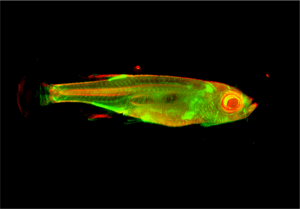Fish in Science: Zebrafish at UCL
By George Wigmore, on 7 December 2011
Related to the much-maligned minnow, many are unaware that zebrafish are in fact one of the giants of the genetics world. While more-well known, and controversial, model organisms continue to dominate the limelight, the humble zebrafish continues to plod along in the background. But a current exhibition at UCL’s Grant Museum on zebrafish and their role in science aims to change all that.
Well-understood, easily observable, and with many similarities to mammalian physiology, it should be no surprise that zebrafish studies have resulted in such a huge number of advances in a plethora of different fields. Ranging from development biology, to toxicology and evolutionary theory, its composition makes it an ideal model organism for studies of vertebrate development and gene function.
Yet despite all the incredible work, outside of the scientific community zebrafish continue to live an anonymous existence, tucked away in their domestic tanks in homes across the world.
Fish have long been used in science, but it wasn’t until the 1970s that zebrafish came to prominence. It was George Streisinger, a researcher at the University of Oregon and founding father of zebrafish research, who first realised that zebrafish’s high reproductive rate and transparent embryos made them an ideal model organism. Since those halcyon days in Oregon, zebrafish have exploded in popularity, becoming the workhorse of vertebrate genetics.
Zebrafish arrived at UCL in 1997 when developmental biologists Nigel Holder and Stephen Wilson joined the university. Since then the Zebrafish Facility has gone from strength to strength, and now holds a staggering 60,000 fish, in addition to being home of The British Association for Zebrafish Husbandry.
So it is with this aim that the Grant Musuem and UCL’s Zebrafish facility have teamed up with an exhibition focusing on zebrafish, looking at the remarkable role these tiny fish play in science. It’s a wonderful example of a research-based exhibition and, due to the Grant Museum’s location, it’s well placed to promote the excellent zebrafish-related research going on in UCL.
Housed in the old Edwardian Medical Library, the Grant Museum’s wooden bookshelves are crammed with fascinating creatures and curiosities, ranging from elephant hearts to the deadly Portuguese Man o’ War. With some collections dating back to the birth of UCL, walking around is an evocative and fascinating experience.
With a combination of pictures ranging from the stark to the beautiful, while compact in size, the exhibition provides an excellent space to explore the science behind cutting-edge research taking place at UCL.
So perhaps with this exhibition zebrafish will finally get the recognition they deserve as the giants of the genetics world, rather than minnows that they’re more closely related to.
George Wigmore is a Media Relations Assistant in UCL Communications & Marketing.
Image caption: green and red tomography image of an adult zebrafish (Credit: Dr Paul Frankel, UCL Division of Medicine and Ark Therapeutics plc and Professor Paul French, Photonics Group, Physics Department, Imperial College London)
 Close
Close


